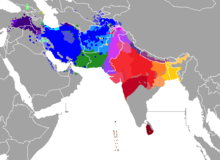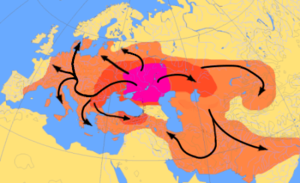இந்தோ ஈரானியர்கள்


இந்தோ ஈரானியர்கள் (Indo-Iranian) [1]ஆரியர் எனத்தங்களை அழைத்துக் கொண்ட இந்தோ-ஈரானிய மக்கள் இந்திய-ஈரானிய மொழிகள் பேசினர். மேலும் இவர்கள் இந்தோ ஐரோப்பிய மொழிகளை யுரோசியா பகுதிகளில் பரப்பினர்.
பெயரிடும் முறை
வரலாற்று அடிப்படையில் ஆரியர் எனும் சொல், இந்திய-ஈரானிய மொழிகளைப் பேசிய பண்டைய பாரசீக மக்கள், வட இந்தியா மற்றும் பாகிஸ்தான் நாட்டின் இந்தோ ஆரியர்களைக் குறிக்கும்.[2][3] பண்டைய அண்மை கிழக்கின் மெசொப்பொத்தேமியாவின் பல பகுதிகளில் இந்தோ-ஈரானிய மக்களின் இராச்சியங்களாக மித்தானி இராச்சியம், இட்டைட்டு பேரரசு, மீடியாப் பேரரசுகள் விளங்கியது.[4][5][6] மனித வரலாறு மற்றும் புவியியல் அடிப்படையில் இந்தோ-ஈரானியர்களை ஆரியர் எனக்குறிப்பிடுகிறது.[7]
தோற்றம்
அன்ட்ரோனோவோ பண்பாட்டின் துவக்க காலத்தில் இந்தோ-ஈரானியர்கள் நடு ஆசியாவின் யுரேசியப் புல்வெளிகளின் அண்ட்ரோனாவா பண்பாட்டைப் பின்பற்றிய ஒரு பொது ஆதி இந்தோ - ஐரோப்பியர்களின் வழித்தோன்றல்கள் ஆவார். முதலில் இந்தோ-இரானியர்கள் தெற்கில் திரான்சாக்சியானா மற்றும் இந்து குஷ் பகுதிகளில் புலம்பெயர்ந்தனர்.[8]
மொழியியல் வரலாற்று அடிப்படையில் இந்தோ-ஈரானிய மொழிகள் கிமு 2,000-இல் பல்வேறு கிளைகளாகப் பல்கிப்பெருகிய போது.[9]:38–39 பரத கண்டத்தில் வேதகால நாகரிகமும் மற்றும் அதன் மேற்கில் பாரசீகப் பண்பாடுகளும் தோன்றிய்து. ஆதி இந்தோ-ஈரானிய மொழிகள் பேசிய மக்களின் வழித்தோன்றல்களிடமிருந்து இந்தியாவின் வடமேற்கில் வேதகால சமசுகிருத மொழியும் மற்றும் பாரசீகத்தில் அவெஸ்தான் மொழியும் தோன்றியது.
புலப்பெயர்வுகள்


Two-wave models of Indo-Iranian expansion have been proposed by Burrow (1973)[11] and (Parpola 1999). The Indo-Iranians and their expansion are strongly associated with the Proto-Indo-European invention of the chariot.
முதன்முதலில் ஆதி இந்தோ ஐரோப்பிய மக்களின் தாயகமான காஸ்பியன் கடலின் வடக்குப் பகுதி மற்றும் அதன் தெற்கின் காக்கேசியாவிலிருந்து, நடு ஆசியா, ஈரானிய பீடபூமி மற்றும் வட இந்தியாவிற்கு புலம்பெயர்ந்ததாக கருதப்படுகிறது. பின்னர் அவர்களில் ஒரு குழுவினர் பண்டைய அண்மை கிழக்கின் மெசொப்பொத்தேமியா மற்றும் சிரியா போன்ற பகுதிகளுக்கு புலம்பெயர்ந்து தேர்களில் குதிரைகளைப் பூட்டி இழுக்கும் முறையை அறிமுகப்படுத்தினர். கிமு 2500 - 2350-களில் சுமேரிய மொழியில் எழுதப்பட்ட களிமண் பலகைகளில் தேர் குறிக்கப்பட்டுள்ளது. பாபிலோனின் மூன்றாவது ஊர் வம்சத்தினரின் (கிமு 2150–2000) குறிப்புகளில் குதிரைகள் பற்றி குறிப்பிடப்பட்டுள்ள்து.
இந்தோ ஆரியர்களின் முதல் இடப்பெயர்வுகள்
அனதோலியாவின் மித்தானி இராச்சியம்
கிழக்கு அனதோலியாவில் கிமு 1500 முதல் அறியப்படும் மித்தானி மக்கள், இந்திய-ஈரானிய மொழிகள் பேசிய ஹுரியத் மக்களின் கலப்பினத்தவர் ஆவர்.[12]:257
இந்தியத் துணைக் கண்டத்தில் வேத கால நாகரீகம்
இந்திய-ஐரோப்பிய மொழிகள் பேசிய மக்கள், நடு ஆசியாவிலிருந்து இந்து குஷ் கணவாய் வழியாக இந்தியத் துணைக் கண்டத்தில் முதன் முதலில் வடமேற்கு இந்தியாவின் சிந்து சமவெளிகளில் வாழ்ந்ததாகவும், பின்னர் கங்கைச் சமவெளிகளில் இடம்பெயர்ந்ததாகவும் ஒரு கோட்பாடு உள்ளது. இவ்வாறு குடியேறிவர்கள் தகளை ஆரியர் என்று அழைத்துக் கொண்டனர். இவர்கள் சமசுகிருத மொழியில் கிமு 1500-இல் இயற்றிய முதல் சமய நூல் ரிக் வேதம் ஆகும். ரிக் வேதம், வேதகாலம்|வேதகாலத்தை]]ச் சேர்ந்தது. ஆரியர்கள் தங்கள் இயற்றிய ரிக் வேத மந்திரங்கள் எழுத்தில் எழுதி வைக்காது, வாயில் மூலமாக பிறர் காதுகளுக்கு பரப்பினர். இதனால் வேத மந்திரங்களை எழுதாக் கிளவி எனப்பெயர் பெற்றது.[12]:258[13] கிமு 1500 முதல் கிபி 500 வரை இந்தோ-ஆரிய மொழிகள் இந்தோ-ஆரிய மொழிகள் வட இந்தியா, மேற்கு இந்தியா, மத்திய இந்தியா, கிழக்கு இந்தியா மற்றும் தென்னிந்தியா பகுதிகளில் பரவியது.
தெற்கு ஆப்கானிஸ்தான் முதல் இந்தியத் துணைக் கண்டத்தின் வங்காளம் முடிய இந்தோ-ஆரியர்கள் பல்வேறு இராச்சியங்களை நிறுவினர்.
ரிக் வேத காலத்திற்கு பிந்திய இராச்சியங்களில் கோசல நாடு, கேகய நாடு, குரு நாடு, பாஞ்சால நாடு, காந்தார நாடு, விதர்ப்ப நாடு, மகத நாடுகள் சிறந்து விளங்கியது. கிமு நான்காம் நூற்றாண்டில் கௌதம புத்தர் மற்றும் மகாவீரர் ஆகியவர்கள், வேதச் சடங்குகளை எதிர்த்து, அகிம்சை மற்றும் கொல்லாமை எனும் கருத்துக்களை வலியுறுத்தியதன் பேரில் வட இந்தியாவில் பௌத்தம் மற்றும் சமண சமயங்கள் தோன்றியது. கிமு 4-ஆம் நூற்றான்டில் மகத நாடு பெரும் பேரரசாக உருவெடுத்தது. கிமு 4-ஆம் நூற்றாண்டில் சந்திர குப்த மௌரியர் மகத நாட்டை வீழ்த்தி மௌரியப் பேரரசை நிறுவினார்.
Iஇந்தோ-ஈரானிய மொழிகளின் தாக்கம் இந்தோ ஆரிய மொழிகளில் ஏற்பட்டு, பின் அம்மொழிகள் இந்தியா, இலங்கை, நேபாளம், வங்காளதேசம் கிழக்கு ஆப்கானித்தான், பாகிஸ்தான் உள்ளிட்ட இந்திய துணைக் கண்டம் முழுவதும் பரவியது.
ஒத்தச் சொற்கள்
ஒரே பொருள் கொண்ட சொற்கள் ஆதி இந்தோ ஈரானிய மொழி, வேத கால சமசுகிருதம் மற்றும் அவெஸ்தான் மொழியில் உள்ளது.[14]
| ஆதி இந்தோ ஈரானிய மொழி | வேதகால சமசுகிருதம் | அவெஸ்தன் | பொதுப் பொருள் |
|---|---|---|---|
| *Hāpš | அப | அபன் | "தண்னீர்" |
| *Hapām Napāts | அபம் நபத் | பர்சு | நீர்த்துளிகள் |
| *aryaman | அர்யமான் | அர்யமான் | ஆரியத் தன்மை (ஆரியக் குடியினன்) |
| *Hr̥tas | ரிதம் | ஆஷா/ அர்த்த | செயலில் உண்மை |
| *atharwan | அதர்வன் | அதௌருன் | "பூசாரி" |
| *Haǰʰiš | அஹி | அஷி | "பாம்பு" |
| *daywas | தெய்வ | தெயிவ | தெய்வீக தேவன் |
| *manu | மனு | மனு | "மனிதன்" |
| *mitra | மித்திரா | மித்திரா | தேவர்களின் ஒருவர் |
| *Hasuras | அசுரா | அஹுரா | அரக்கர |
| *sarwatāt | சரஸ்வதி | ஹௌர்வததாத் | கல்விகான தேவதை |
| *SaraswatiH | சரஸ்வதி ஆறு | ஹரஸ்வதி | வேதகால ஆறு |
| *sawmas | சோமா (சோம பானம் செய்ய பயன்படும் சோமக் கொடி) | ஹோமா | புனிதச் செடி |
| *suHar ~ *suHr̥ | சூரியா | 'ஹவரே | சூரியன் அல்லது சூரிய பகவான் |
| *top ~ *tep | Tapati | tapaiti | Possible fire/solar goddess; see Tabiti (a possibly Hellenised Scythian theonym). Cognate with Latin tepeo and several other terms. |
| *wr̥tras | Vrtra- | verethra, vərəϑra (cf. Verethragna, Vərəϑraγna) | "obstacle" |
| *Yamas | Yama | Yima | son of the solar deity Vivasvant/Vīuuahuuant |
| *yaĵnas | yajña | yasna, object: yazata | "worship, sacrifice, oblation" |
இதனையும் காணக
மேற்கோள்கள்
- ↑ Naseer Dashti (8 October 2012). The Baloch and Balochistan: A historical account from the Beginning to the fall of the Baloch State. Trafford Publishing. பன்னாட்டுத் தரப்புத்தக எண் 978-1-4669-5897-5.
- ↑ The "Aryan" Language, Gherardo Gnoli, Instituto Italiano per l'Africa e l'Oriente, Roma, 2002.
- ↑ Schmitt, "Aryans" in Encyclopedia Iranica: Excerpt:"The name “Aryan” (OInd. ā́rya-, Ir. *arya- [with short a-], in Old Pers. ariya-, Av. airiia-, etc.) is the self designation of the peoples of Ancient India and Ancient Iran who spoke Aryan languages, in contrast to the “non-Aryan” peoples of those “Aryan” countries (cf. OInd. an-ā́rya-, Av. an-airiia-, etc.), and lives on in ethnic names like Alan (Lat. Alani, NPers. īrān, Oss. Ir and Iron.". Also accessed online [1] in May, 2010
- ↑ Durant, Will: Our Oriental Heritage. New York: 1954. Simon and Schuster. According to Will Durant on Page 286: “the name Aryan first appears in the [name] Harri, one of the tribes of the Mitanni. In general it was the self-given appellation of the tribes living near or coming from the [southern] shores of the Caspian sea. The term is properly applied today chiefly to the Mitannians, Hittites, Medes, Persians, and Vedic Hindus, i.e., only to the eastern branch of the Indo-European peoples, whose western branch populated Europe.”
- ↑ Häkkinen, Jaakko (2012). "Early contacts between Uralic and Yukaghir". In Tiina Hyytiäinen; Lotta Jalava; Janne Saarikivi; Erika Sandman (eds.). Per Urales ad Orientem (Festschrift for Juha Janhunen on the occasion of his 60th birthday on 12 February 2012) (PDF). Helsinki: Finno-Ugric Society. பன்னாட்டுத் தரப்புத்தக எண் 978-952-5667-34-9. பார்க்கப்பட்ட நாள் 12 November 2013.
- ↑ Häkkinen, Jaakko (23 September 2012). "Problems in the method and interpretations of the computational phylogenetics based on linguistic data – An example of wishful thinking: Bouckaert et al. 2012" (PDF). Jaakko Häkkisen puolikuiva alkuperäsivusto. Jaakko Häkkinen. Archived from the original (PDF) on 1 செப்டம்பர் 2013. பார்க்கப்பட்ட நாள் 12 November 2013.
{cite web}: Check date values in:|archive-date=(help) - ↑ Cavalli-Sforza, Luigi Luca; Menozzi, Paolo; Piazza, Alberto (1994), The History and Geography of Human Genes, Princeton, New Jersey: Princeton University Press, p. See "Aryan" in index, பன்னாட்டுத் தரப்புத்தக எண் 978-0-691-08750-4
- ↑ Anthony 2007, ப. 49.
- ↑ (Mallory 1989)
- ↑ Christopher I. Beckwith (2009), Empires of the Silk Road, Oxford University Press, p.30
- ↑ Burrow 1973.
- ↑ 12.0 12.1 (Mallory & Mair 2000)
- ↑ Rigveda – Britannica Online Encyclopedia
- ↑ Cite warning:
<ref>tag with nameGnolicannot be previewed because it is defined outside the current section or not defined at all.
ஆதாரம்
- Anthony, David W. (2007), The Horse The Wheel And Language. How Bronze-Age Riders From the Eurasian Steppes Shaped The Modern World, Princeton University Press
- Bryant, Edwin (2001), The Quest for the Origins of Vedic Culture: The Indo-Aryan Migration Debate, Oxford University Press, பன்னாட்டுத் தரப்புத்தக எண் 978-0-19-513777-4
- Burrow, T. (1973), "The Proto-Indoaryans", Journal of the Royal Asiatic Society of Great Britain and Ireland (2): 123–140, JSTOR 25203451
- Diakonoff, Igor M.; Kuz'mina, E. E.; Ivantchik, Askold I. (1995), "Two Recent Studies of Indo-Iranian Origins", Journal of the American Oriental Society, American Oriental Society, vol. 115, no. 3, pp. 473–477, எண்ணிம ஆவணச் சுட்டி:10.2307/606224, JSTOR 606224.
- Jones-Bley, K.; Zdanovich, D. G. (eds.), Complex Societies of Central Eurasia from the 3rd to the 1st Millennium BC, 2 vols, JIES Monograph Series Nos. 45, 46, Washington D.C. (2002), பன்னாட்டுத் தரப்புத்தக எண் 0-941694-83-6, பன்னாட்டுத் தரப்புத்தக எண் 0-941694-86-0.
- Kuz'mina, Elena Efimovna (1994), Откуда пришли индоарии? (Whence came the Indo-Aryans), Moscow: Российская академия наук (Russian Academy of Sciences).
- Kuz'mina, Elena Efimovna (2007), Mallory, James Patrick (ed.), The Origin of the Indo-Iranians, Leiden Indo-European Etymological Dictionary Series, Leiden: Brill
- Mallory, J.P. (1989), In Search of the Indo-Europeans: Language, Archaeology, and Myth, London: Thames & Hudson.
- Mallory, J. P.; Adams, Douglas Q. (1997), "Indo-Iranian Languages", Encyclopedia of Indo-European Culture, Fitzroy Dearborn.
- Mallory, J. P.; Mair, Victor H. (2000), The Tarim Mummies: Ancient China and the Mystery of the Earliest People from the West, London: Thames & Hudson.
- Parpola, Asko (1999), "The formation of the Aryan branch of Indo-European", in Blench, Roger; Spriggs, Matthew (eds.), Archaeology and Language, vol. III: Artefacts, languages and texts, London and New York: Routledge.
- Sulimirski, Tadeusz (1970), Daniel, Glyn (ed.), The Sarmatians, Ancient People and Places, Thames & Hudson, பன்னாட்டுத் தரப்புத்தக எண் 0-500-02071-X
- Witzel, Michael (2000), "The Home of the Aryans" (PDF), in Hintze, A.; Tichy, E. (eds.), Anusantatyai. Fs. für Johanna Narten zum 70. Geburtstag, Dettelbach: J.H. Roell, pp. 283–338.
- Chopra, R. M., "Indo-Iranian Cultural Relations Through The Ages", Iran Society, Kolkata, 2005.
வெளி இணைப்புகள்
- THE INDO-IRANIAN LANGUAGES
- The Origin of the Pre-Imperial Iranian People by Oric Basirov (2001)
- The Origin of the Indo-Iranians Elena E. Kuz'mina. Edited by J.P. Mallory (2007)